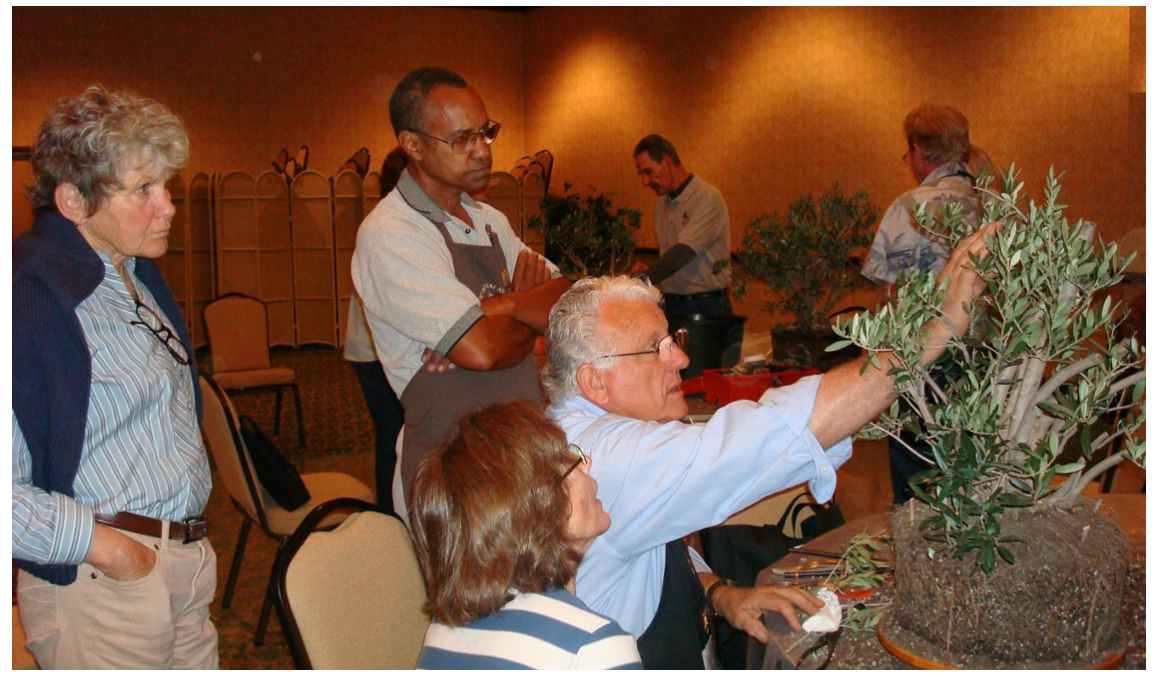Warren Hill at his one-man show at East Tennessee State University in the late 1990s. Trees (from left to right): American Hornbeam, Bald Cypress and Ginkgo Biloba, also known as Chi Chi Ginkgo
Not many people can recall experiencing a specific, life-altering moment. But Warren Hill attests that his personal and professional paths completely changed after he walked into a bonsai exhibition hosted by the California Bonsai Society (CBS) in 1960.
For this final edition of Museum Curators, we spoke with Hill, who presided over the National Bonsai & Penjing Museum from 1996 to 2001. Though he didn’t practice bonsai growing up or in school, Hill always had a deep interest in Japanese culture and said he was immediately hooked on the art of bonsai after walking into the CBS show.
“I had no idea what I was looking at, but I knew it was magnificent,” he said of the exhibition.
But Hill’s adoration for bonsai didn’t come totally out of the blue. In college, he majored in engineering and horticulture, his affinity for which stems from his Scandinavian parents. His father was Finnish and his mother was Swedish and held a passion and talent for gardening. Hill was born in Minneapolis, Minnesota, which shares a cold climate with Scandinavian countries known for their appreciation of the arts, including horticulture.
“Horticulture is in my background and my heritage,” Hill said.
Left: One of Warren Hill’s Satsuki Azalea in Informal upright-bunjin, propagated by cutting
Right: One of his trident maples in the yose-ue style, propagated by seed
He was working in the engineering industry when he stumbled upon the CBS exhibition that piqued his interest in bonsai. Hill immediately started collecting business cards from professionals present at the event and got to know bonsai masters like John Naka through a mutual love for nature and Japanese art.
“There are many similarities between the cultures of Scandinavia and Japan,” Hill said. “Every place you go in Japan it’s all about the art. In the simplest house you’ll find it’s almost a shrine to the art, which is kind of the way the Scandinavians feel.”
He began to read everything about bonsai he could get his hands on and studied with Naka and other masters like Saburo Kato and Frank Nagata. In 1974, Hill started to teach and give bonsai lectures, demonstrations and workshops for local and international practitioners and groups.
Left: Hill critiquing a black pine of Jack Fried, a former president of the Midwest Bonsai Society. Right: Hill helping a student at a bonsai workshop work on their Shimpaku Juniper. Hill traveled around the world to style trees at student workshops.
After one class on trident maples, Hill was invited to tour around East Tennessee by a friend of his who needed someone to practice bonsai with. Hill was sold on the area and moved from California to Tennessee to work on trees and, coincidentally, meet his future wife.
Shortly after, he received a letter from the U.S. National Arboretum that the Museum curator position was open and they wanted him to apply. He sent in his application, interviewed, and secured the job as the Museum’s second-ever curator.
“It was an honor to even be asked to be interviewed for the job,” Hill said. “It was a rich position, and I really enjoyed it.”
He said the nicest part of the position was meeting and working with the collection of Museum volunteers to take care of the Museum’s masterpiece bonsai.
“All those nice people who helped out all loved the art as I did,” Hill said. “You meet so many talented people like them and masters like Kato and Naka who were all special and of exceptional quality. When you know the background of people like them and know how gifted they are, you’re kind of in awe when you’re around them.”
California State Convention – Hill is holding a workshop for students in Anaheim, California. They are working with olive trees.
After Hill retired from the curatorship, he and his wife moved back to Tennessee. He opened Tree-Haven, a bonsai school that taught students from all over the world, and he fell in love with teaching again.
“I like watching the students’ eyes light up when you tell them the answer to a question,” he said.
For his years of excellent teaching, the Golden State Bonsai Federation awarded Hill the Circle of Sensei Award in 2013. Other distinguished recipients of the award include Ben Oki, John Naka and Harry Hirao.
Hill remembers sharing with bonsai students that, to be a successful bonsai practitioner, you have to hold a deep love and passion for nature – that will guide you in the right direction.
Warren used his own drawings of different bonsai styles to show students an idea of what the style looks like. This is Chokkan, which has a formal upright trunk. The majestic appearance represents a large, tall tree standing in the mountains or on a vast low-land plain. Usually the tree's outline is in a pyramidal form.






